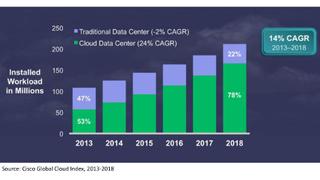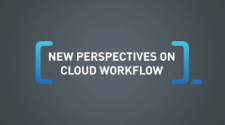A Guide to Cloud Storage in the Media Industry
SAN JOSE, CALIF—The storage and compute cloud have moved past the hype stage and are now serious contenders for media workflow integration. Forward-thinking designers are integrating cloud resources into their workflows and leveraging their scale, on-demand agility and reliability. But it can be a long distance run to seamlessly integrate existing workflows into the cloud. Where does one start? One area that is maturing fast is the integration of on premise storage with the public cloud.
The Cisco Global Cloud Index report predicts that the cloud data center will execute 78 percent of all IT workloads by 2018, compared to 22 percent for traditional (on premise) data centers. Media system and product designers can’t afford to buck this momentum.

There are several strategies to connect an on premise workflow to the cloud. One is a do-it-yourself approach where facility engineers write the myriad of programming messages that connect local media processes to the cloud. Not easy and challenging to maintain. A different slant is to select a provider that already offers cloud integration in their products.
Recently TV Technology published a White Paper “Cloud Storage Technologies Show Promise for Media Workflows”. The paper is a commentary on the results of a survey for cloud media storage from 1,750 responders in the media industry. One of the telling results is that 26 percent of responders would purchase a facility-side storage system that was seamlessly integrated with the public cloud. This is significant and a strong sign that cloud-integrated solutions offer great value. Managers and technical staff need the assurance that the product “just works” with the cloud hidden from the actual workflow.
Some major broadcasters are setting the pace by purchasing integrated solutions for both the private and public cloud. Consider the thoughts of Vince Roberts:
“Disney ABC Television Group is actively using private cloud facilities for archive and near line storage of distribution assets. In addition, we are planning to use the public cloud with its incredible resource agility for overflow “pop up” and intermittent events. As with all of our cloud efforts the safety and security of our programming content is paramount” --- Vince Roberts, Executive Vice President Global Operations and Chief Technology Officer Disney ABC Television Group
Bottom line, many cloud integrated products offer the benefits of the cloud without the workflow integration headaches.
Industry expert Al Kovalick and TV Technology Editor Tom Butts get deeper into this just-released data with storage experts from Quantum. Click here for more on industry experiences and perceptions about using cloud storage.
SOLUTIONS FROM QUANTUM
Quantum, a world leader in storage management solutions, has developed a portfolio of cloud integrated products under the Q-Cloud banner. Q-Cloud is a family of software modules for the flagship StorNext 5 product; a File System and Storage Manager. StorNext is popular in media facilities and enables users to collaborate more easily with globally shared file assets.
Q-Cloud adds the cloud tier to the storage hierarchy (primary, secondary, tape, cloud) managed by StorNext. There are no appliances to install. Users set the policies for when to use the cloud tier of storage. The family includes Q-Cloud Archive, Vault and Protect. These links will give you more information on the Q-Cloud family and their benefits in integrated cloud storage workflows.

For a short video review of the benefits of integrated cloud storage workflows, click here.

For the Q-Cloud family overview, click here.

For a more in-depth review of the Q-Cloud’s features and benefits, click here.
Integrated cloud storage for the media facility is not hype; it’s reality today.
Get the TV Tech Newsletter
The professional video industry's #1 source for news, trends and product and tech information. Sign up below.
